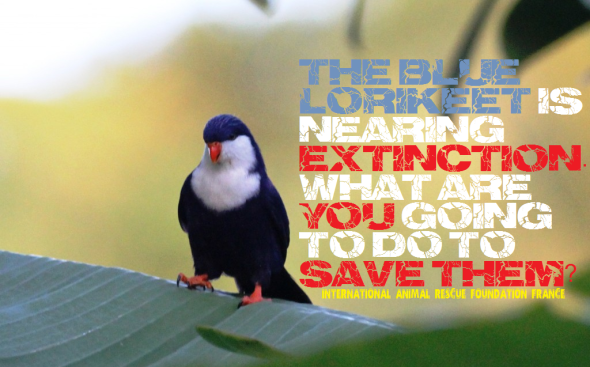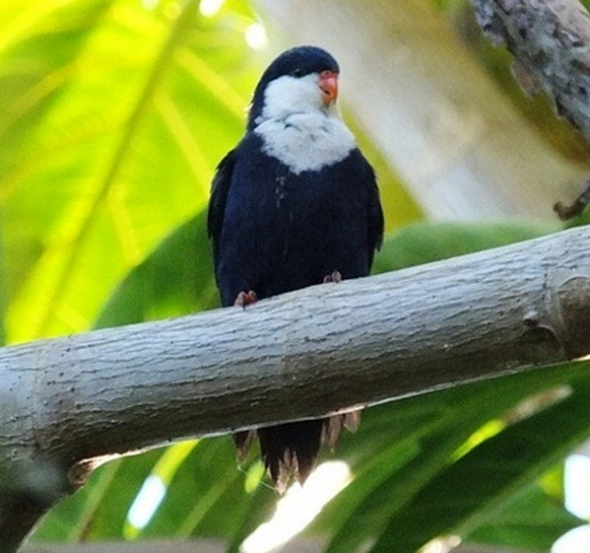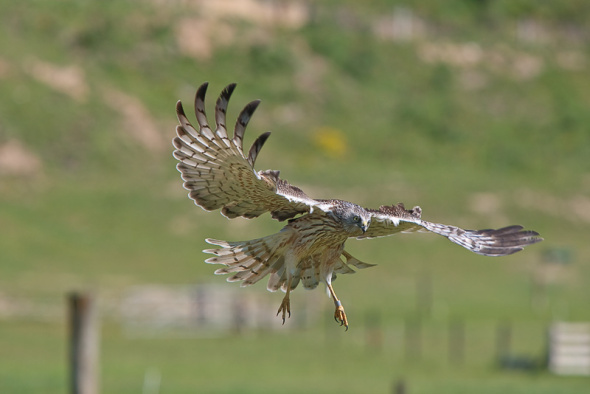ENDANGERED SPECIES FRIDAY: PTILINOPUS CORALENSIS | ATOLL FRUIT DOVE.
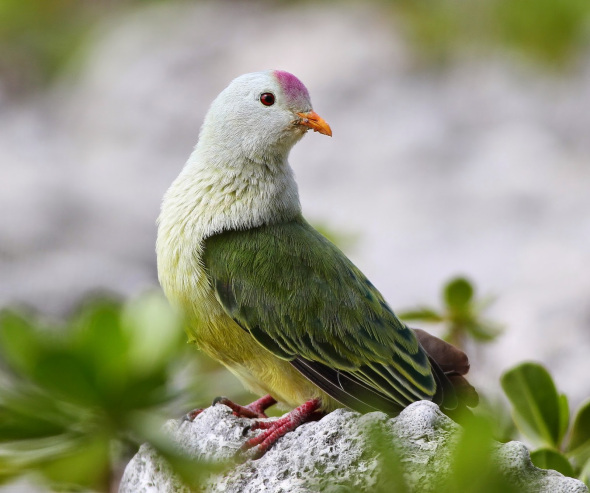
ENDANGERED SPECIES FRIDAY: PTILINOPUS CORALENSIS | ATOLL FRUIT DOVE
This Friday’s Endangered Species Post brushes up on a species of bird that many of you may never have heard of. The atoll fruit dove, that’s listed as (near threatened) is unfortunately nearing extinction within its endemic wild. Image: Atoll Fruit Dove, credits, Steve Smith.
Endemic to French Polynesia, the species was formally identified back in 1848 by Dr Titian Ramsay Peale (November 2, 1799 – March 13, 1885) who was an American artist, naturalist, entomologist, and photographer. He was the sixteenth child and youngest son of noted American naturalist Charles Willson Peale. He is sometimes referred to as Titian Ramsey Peale II to distinguish him from his older brother with the same name who was a favorite of their father and who died at age 18 in 1798.
From 1988 the atoll fruit dove was previously listed as lower risk/least concern, data from that period showed no reasonable justification for the bird to be listed as threatened due to the species being heavily populated throughout the French Polynesia islands. Unfortunately things have drastically changed since the the late 1980’s. French Polynesia is now home to many French and non-French citizens, all of which are gradually threatening the atoll fruit doves habitat - and many other animals too.
Data records prove that from the 1980’s right through to the new millennium the species did live a pretty undisturbed life. However come 2004 the atoll fruit doves habitat and their existence took a turn for the worse. From 2004-2016 the species was (re-listed as near threatened). Populations are still decreasing, and from what we are aware of to date, there has been no official records kept that can prove the current population size which we do find rather strange. French Polynesia isn’t exactly your largest island on the planet.
What does near threatened mean though? Below I’ve extracted a paragraph from the International Union for the Conservation of Nature that will help you understand more about this ‘category‘.
“A taxon is Near Threatened when it has been evaluated against the criteria but does not qualify for Critically Endangered, Endangered or Vulnerable now, but is close to qualifying for or is likely to qualify for a threatened category in the near future“
Scientifically identified as Ptilinopus coralensis, the species is widespread throughout the islands of the Tuamotu Archipelago, French Polynesia. It is likely to occur at low densities throughout its range as its preferred food resources are scarce. In a recent survey it was found to be uncommon on five out of eight islands visited, but others have found it to be abundant on some atolls which have remained free from the ravages of introduced predators.
Scientists haven’t as located any ‘sub-populations’, however have confirmed that there is a ‘continuous decline of mature individuals on the island examined’ however as yet we still don’t know to what extent other than a 30% drop in populations have been recorded.
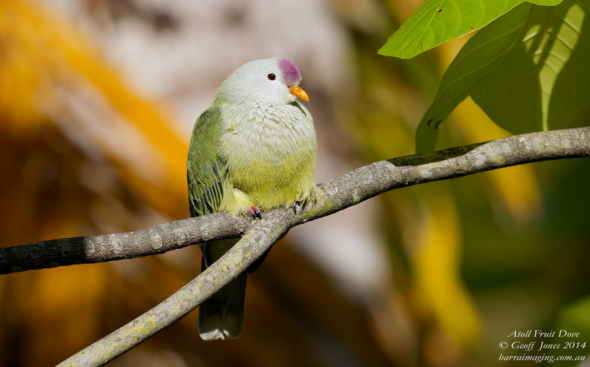
Image: (Google Image Search): Atoll fruit dove (Credits: Geoff Jones 2014)
The atoll fruit dove is the world’s only dove in the tropical Pacific that has adapted exclusively to low coral atolls. It lives in forests and abandoned coconut plantations. It mainly feeds on insects and seeds, usually on the ground. This species also eats the leaves of the “tafano” or “kahaia” (Guettarda speciosa ) trees with odorous flowers.
THREATS
Predation by introduced rats (particularly black rat Rattus rattus) is a threat on a small number of atolls and the species is vulnerable to habitat destruction including the exploitation of coconut plantations. The species is also reported to be rather tame, and is rare on inhabited islands, so hunting may also be a threat.
Although the species is commonly known throughout the French Polynesian islands - there is still to date very little known about the bird. The issue with coconut plantation/exploitation has always been somewhat of a concern for myself and the team. In a sense its no different to be honest than the palm oil trade (however in this case, its coconut farming that is placing the species in danger to some extent!).
I am working with a number of conservationists on the French Polynesia islands that are keeping me updated on this issue overseas, as well as the cruel and barbaric dog and cat meat trade. For now our main priority is to ensure that we undertake a census in relation to the current atoll fruit dove population, examine the threats, and work how to minimize them threats (Etc).. ..Unfortunately though I cannot provide any further up to date information relating to this bird and whether the specie will be extinct soon.
Dr Jose Carlos Depre: PhD. MEnvSc. BSc(Hons) Botany, PhD(NeuroSci) D.V.M
Master of Environmental, Botanical & Human Science.
Chief Environmental Officer and CEO.
Endangered Species Monday: Vini peruviana.
Endangered Species Monday: Vini peruviana
This Monday’s endangered species watch post (ESP) I document on a rather elusive bird that is rarely spoken about within the conservation theater or among animal rights organisations. Listed as (vulnerable) the species was formally identified by Professor Philipp Ludwig Statius Müller (April 25, 1725 – January 5, 1776) was a German zoologist. (Image V. peruviana, photographer Tara)
Statius Müller was born in Esens, and was a professor of natural science at Erlangen. Between 1773 and 1776, he published a German translation of Professor Linnaeus’s Natursystem. The supplement in 1776 contained the first scientific classification for a number of species, including the dugong, guanaco, potto, tricolored heron, umbrella cockatoo, red-vented cockatoo, and the enigmatic hoatzin. He was also an entomologist.
Despite the birds high population size the Blue Lorikeet-scientifically named as Vini peruviana is under threat from feral cats, accidental introduction of black rats and violent storms that hit the birds native range frequently causing untold damage and catastrophic destruction to the specie habitat. Furthermore the ‘swamp harrier’ remains an all out threat to Blue Lorikeet’s range which has led to wide range species decline. Swamp Harriers predate on the Blue Parikeet mainly due to the birds color.
Endemic to the Cook Islands and French Polynesia, Blue Lorikeet population sizes are declining quite fast of which drastic conservation measures are now required to control feral cats and the accidental introduction of black rats, not forgetting measures to either reduce swamp harriers or introduce a non-endangered prey for the harrier. The last survey which I believe was undertaken sometime back in 2012 showed a ‘global population’ estimated to be at 7,200 to 9,000 individuals. Which is still quite high, however not high enough to stop the species qualifying for the classification of (endangered).
Taking into consideration range and overall total population size (at an estimate) the species falls into the ‘band’ of 2,500 to 9,000 individuals. This equates (exactly) to 1,677-6,666 ‘mature individuals’ rounded to 1,500-7,000 mature individuals. Summarizing; the exact total population size could be as low as 1,500 but no greater than 7,000 mature individuals (which is extremely concerning).
Blue Lorikeet’s have been recorded within twenty of the south-east Polynesia islands, unfortunately on seven of these islands the species has since been declared officially extinct. The species now remains sparsely distributed on some thirteen islands of which is threatened by rats, feral cats and the swamp harrier. We now know the species is situated within the Society Islands (formerly all), the northern atolls of the Tuamotu Archipelago (both French Polynesia), and Aitutaki (Cook Islands).
Image: Blue Lorikeet - Vini peruviana
Within the Society Islands conservation teams estimated that there were some 200-400 individual pairs on the Motu One and Manuae respectively in 1973 , however this may no longer be the case. On the Maupihaa island back in 1999 conservationists that believed the species to be extinct located breeding pairs. In Tuamotus 2006 surveys have shown the following data in relation to population sizes; Kaukura (1,000), Rangiroa (1,000), Arutua (500), Apataki (200) and Tikehau (50).
Meanwhile in Tiamanu Motu in Apataki atoll a minimum 300 individuals were estimated back in 1989 (this sub-population being allegedly smaller than 10 years previously). On Aitutaki, where it was probably introduced, numbers have been estimated at under 500 pairs, 2,400 individuals and 1,000 individuals (2006).
Following the devastation of Cyclone Pat (2010) a further census was undertaken to asses the impacts of freak weather patterns and catastrophic cyclones on the species. Distance sampling surveys on the island of Aitutaki (2011) showed a decrease in population size of exactly 1,400 individuals. That’s quite a substantial decline of individuals caused directly by a single yet destructive cyclone.
Blue Lorikeets depend on coconut palms for nesting and some of its food, and will frequent cultivated areas. They also roost in palm trees, rising at dawn and calling and preening before feeding. They are usually found in small flocks of less than ten birds. They are active birds, feeding on nectar, insects, and ground forage.
Image: Swamp Harrier (Wiki) - . Circus approximans
Threats
The species’s extinction from many islands is most likely due to predation by black rat Rattus rattus and to a lesser extent, feral cats Felis catus. Blue Lorikeet’s have gone extinct from Makatea in the Tuamotus could have been accelerated by a particularly violent hurricane. Its range reduction in the Society Islands correlates with the spread of the introduced Swamp Harrier Circus approximans. The accidental introduction of black rats to the islands where Blue Loirkeet persists is a continuing threat to the species. Listed on Cites Appendix II conservation actions are under way with more projects proposed.
Thank you for reading.
Dr Jose. C. Depre
Botanical and Environmental Scientist.

